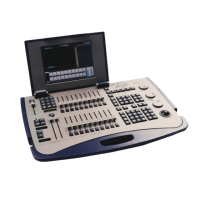Returning to MEM time
Keypresses Results/Comments
1. Press [A/B RATE]
The key’s LED goes off. The fade rate is
displayed on a gray background.
2. Press on [GO] or [BACK] The crossfade is executed in memory time.
MEM
is displayed on the Playback display.
Split crossfaders and moving lights
When the crossfaders are split (for example, A is on 30% and B is on 60%), spots and
scrollers are controlled differently than channels. Channels are always on a Highest Takes
Precedence basis. Fader A controls spots and scrollers.
If A is the active fader (both A and B at the upper end stop), moving fader B does
not
affect
the spots and scrollers. Moving fader A, fades spots and scrollers from the values in the
assignment on A to the values in the assignment on B. Continuous parameters fade.
Discrete step and mixed step parameters jump when the A fader is moved off its end stop.
Example: Fader A is the active fader. Spot 5 is output from A and all parameters have a
value of FL. the incoming memory (on B) also contains spot 5 with all parameter values at
50. Move fader A from its end stop. The parameter values fade from FL to 50 (the value in
the incoming memory).
If B is the active fader (both A and B at their lower end stop), moving fader B fades
parameters to their values in assignment A.

